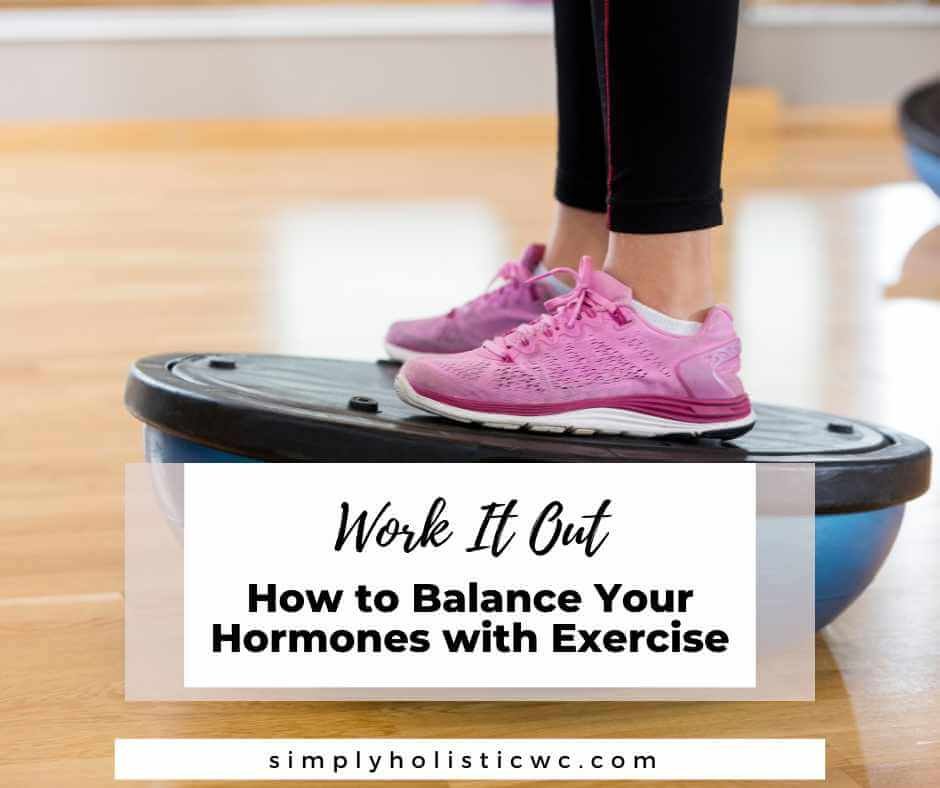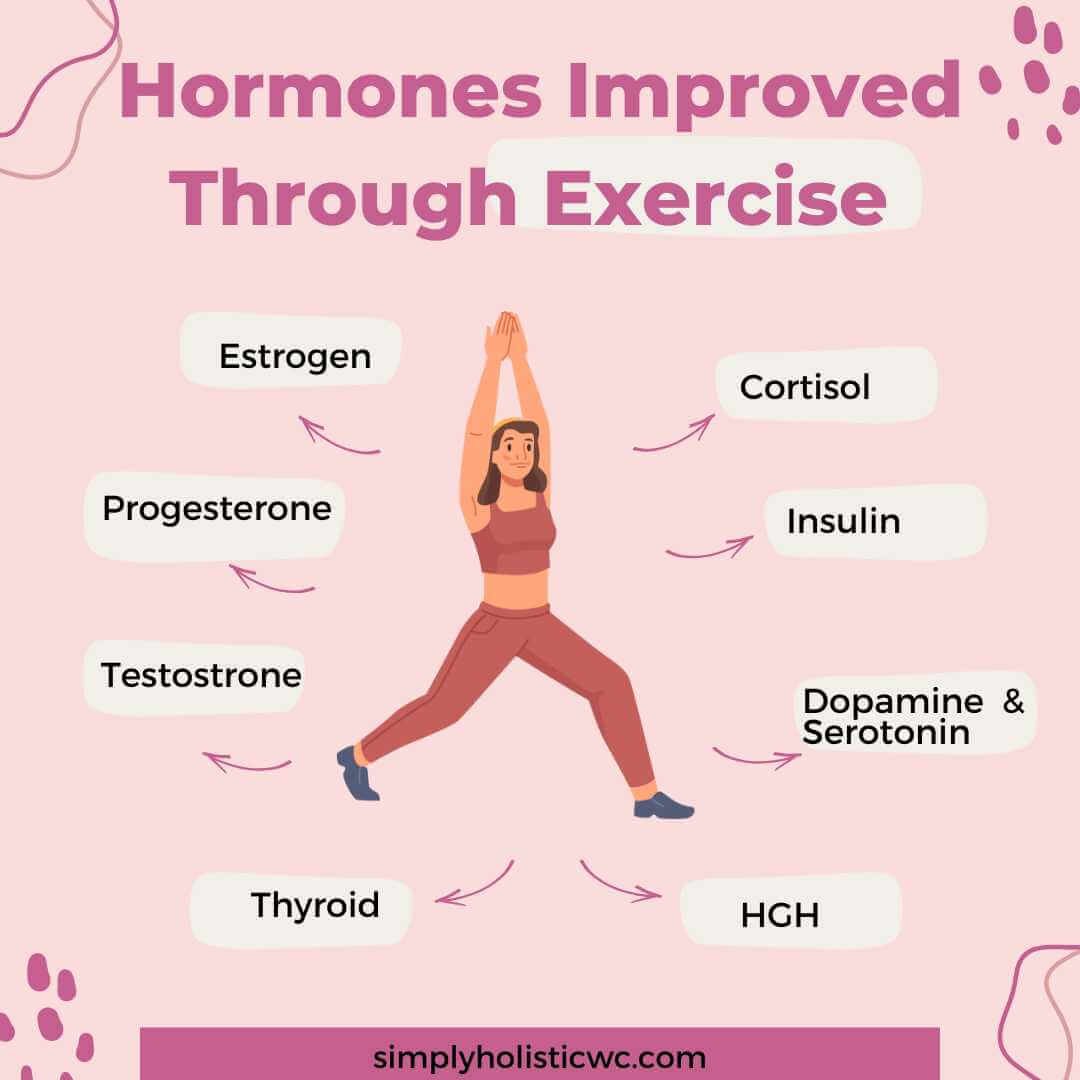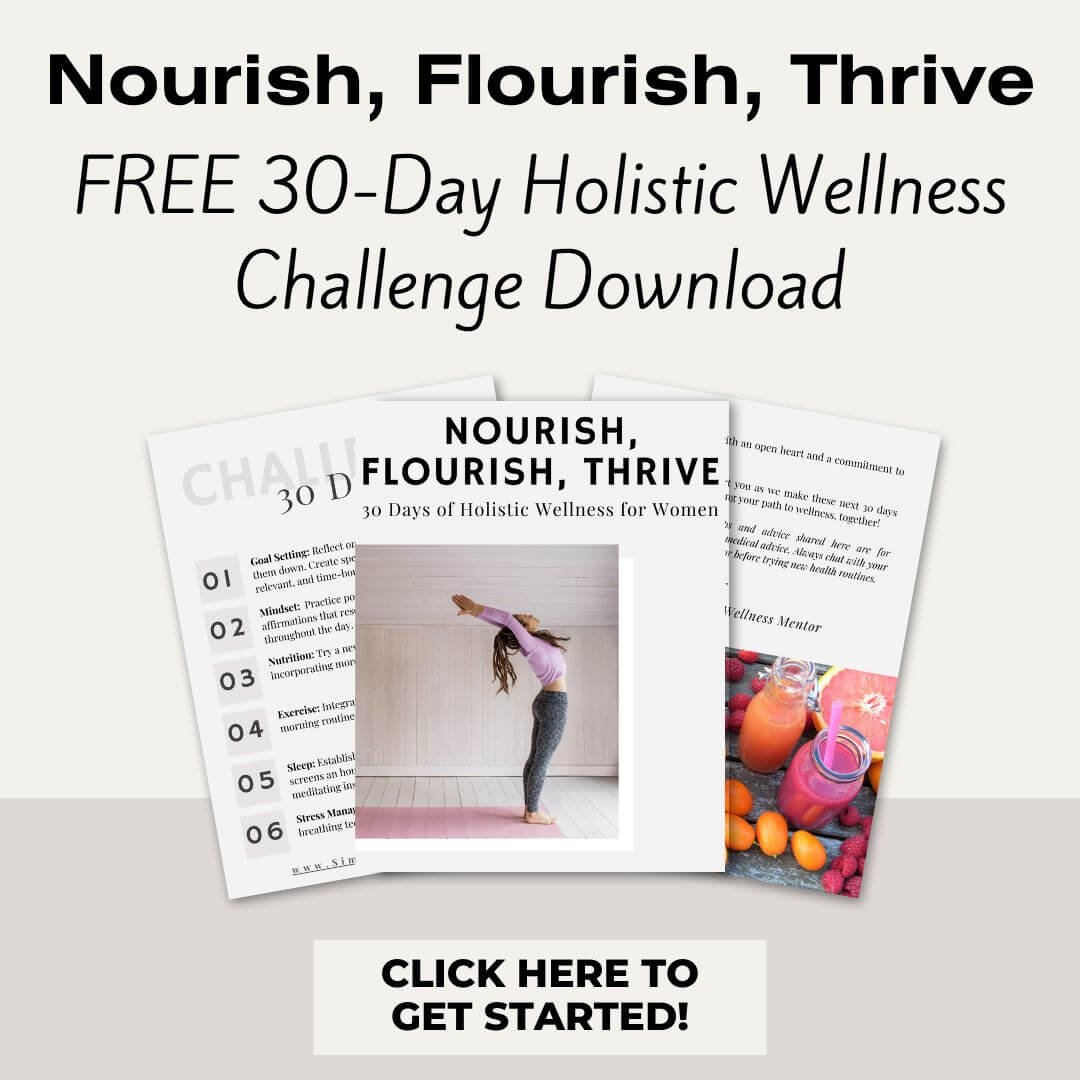How to Balance Your Hormones with Exercise

Are you feeling out of balance in life? Do fatigue, mood swings, and other hormonal issues have you down? If so, don’t worry – exercise can bring your body back into harmony!
In this blog post, we’ll discuss how the right kind of physical activity will help to regulate your hormones naturally and get back on track.
From the best workouts to strategies for fitting exercise into a busy lifestyle, let’s look at how exercise can benefit your health and happiness!
This post may contain affiliate links for which I may earn a small commission. This means shopping through these links supports my blog at no cost to you. Please read my full policy. Thank you!
How Does Exercise Affect Female Hormones?
Hormone levels affect everything from weight gain to the immune system to energy levels and more.
Getting your sweat on can do wonders for hormonal imbalance and keeping your body functioning at its best!
Let’s dive into how exercise affects some key hormones in women and how you can use this knowledge to your advantage.
1. Estrogen
As one of the main hormones responsible for regulating the menstrual cycle, estrogen plays a crucial role in women’s health.
Many conditions, such as polycystic ovary syndrome (PCOS) and endometriosis, are associated with excess estrogen.
Luckily, regular exercise can help regulate estrogen levels, leading to more regular periods, fewer symptoms of PMS, and hormonal balance.
You May Also Enjoy:
Estrogen Detox Diet Plan to Balance Hormones Naturally
PCOS Diet: 15 Foods to Eat and 7 Foods to Avoid
PCOS Acne: What Causes it and 19 Ways to Treat it Naturally
A Holistic Approach to Weight Loss with Endometriosis
How to Battle Endometriosis Acne Naturally
2. Progesterone
Another hormone involved in the menstrual cycle is progesterone. Regular exercise can help reduce levels of cortisol – AKA the stress hormone.
High levels of cortisol can actually suppress the secretion of progesterone levels, leading to all sorts of hormonal imbalances.
You May Also Enjoy:
Foods to Increase Progesterone Naturally
3. Testosterone
Did you know that women produce testosterone too? Regular exercise can increase women’s testosterone levels, leading to increased muscle mass and bone density as well as improved libido and energy levels.
4. Thyroid
The pituitary gland helps control thyroid hormone levels. Exercise can help regulate thyroid hormones by increasing metabolism and reducing inflammation. This leads to better energy levels and can even aid in weight loss.
5. Cortisol
Cortisol is secreted by the adrenal glands. The stress hormone cortisol can wreak havoc on our bodies if left unchecked.
Luckily, exercise is a natural stress reliever and can help decrease cortisol levels. This can lead to an improved mood and reduced anxiety levels.
You May Also Enjoy:
The Surprising Link Between Gut Health and Hormonal Balance
Your Guide to A Stress-Reducing Bedtime Routine
12 Powerful Relaxation Techniques for Work Stress
Free Printable Gratitude Journal with Prompts
6. Insulin
When it comes to our bodies’ endocrine system, insulin plays a big role in regulating our blood sugar levels.
Regular exercise can help increase insulin sensitivity, allowing the body to use glucose more effectively.
This can lead to improved blood sugar levels, reduced risk of developing Type 2 diabetes, and improved insulin resistance.
7. Dopamine and Serotonin
These neurotransmitters play a crucial role in regulating mood and overall well-being.
Exercise has been shown to increase the production of these chemicals in the brain, leading to improved mental health, reduced stress levels, and an overall sense of happiness.
8. Human Growth Hormone
Exercise can help boost our levels of human growth hormone (HGH).
HGH is a hormone produced by the pituitary gland that plays an important role in growth and development. It also regulates body composition, muscle and bone growth, and metabolism.
As we age, our HGH levels naturally decrease, which can contribute to a number of age-related health issues.

Best Exercises to Balance Female Hormones
You’re probably wondering, what are the best exercises for a hormone imbalance? I’ve got you covered!
The good news is that there’s no one-size-fits-all answer to this question – the best exercise for you will depend on your individual needs and preferences.
Please note that this post is not a substitute for medical advice. Always consult a healthcare provider before changing your diet or exercise routine.
That being said, here are a few types of exercise that have been shown to have hormone-balancing benefits:
1. Strength Training
Looking to boost your confidence while improving your overall health?
Look no further than lifting weights or doing bodyweight exercises like push-ups and squats!
These exercises have been shown to increase testosterone levels in women, leading to improved muscle mass and bone density.
Plus, you’ll feel like a total powerhouse with all that extra strength!
Ready to get started? Here are a few products I love for lifting weights and bodyweight exercises:
- Resistance bands: Perfect for adding extra resistance to your squats and lunges, these bands are versatile and easy to use.
- Dumbbells: Whether you’re a beginner or a seasoned weightlifter, dumbbells are an excellent tool for building strength and toning muscles. I love these dumbbells because they are adjustable, which saves money and space!
- Yoga mat: While not specifically designed for weightlifting, a good yoga mat can provide some extra cushioning for your bodyweight exercises.
2. Walking
Walking is a great aerobic exercise to incorporate into your routine. Going for a brisk walk can be a great way to get your blood flowing and reduce stress levels. Plus, it’s low-impact and easy to incorporate into your daily routine.
3. Swimming
Looking for a full-body workout that’s easy on the joints? Swimming may be the answer.
Not only does it burn calories and improve cardiovascular health, but it can also help reduce inflammation and regulate thyroid hormones.
You May Also Enjoy:
Best Home Exercise Equipment | Amazing for Weight Loss!
4. Stretching
Taking the time to stretch regularly can help reduce stress levels and improve flexibility.
Yoga is an excellent option for combining stretching with mindfulness and breathwork.
If you’re new to yoga, no worries – plenty of great resources are out there to help you get started!
Check out these fantastic products that are perfect for any aspiring yogi:
- Gaiam Essentials Yoga Block: This block helps support and deepen your stretches, making it easier to achieve proper alignment and improve flexibility.
- Gaiam Essentials Thick Yoga Mat: This high-quality mat provides excellent grip and cushioning, ensuring you can practice safely and comfortably. Plus, it’s lightweight and easy to carry to and from class!
- Yoga Design Lab Combo Mat: This eco-friendly mat combines a towel and mat in one, making it perfect for hot yoga or any style of yoga where you might work up a sweat. Plus, it comes in a variety of beautiful designs!
5. Not Sitting for Too Long
Alright, let’s get real for a second – sitting for extended periods is no bueno for our health.
Not only can it lead to some serious aches and pains and an increased risk for heart disease, but it’s also been linked to hormone imbalances. Yikes!
But there are plenty of products out there to help keep you moving throughout the day.
Here are a few of my favorites:
- Standing desk: If you can switch up your workspace, a standing desk can be a game-changer for reducing the time you spend sitting. I also use a cushioned mat to stand on for added comfort when standing!
- Treadmill desk: Want to get some exercise in while you work? A treadmill desk allows you to walk while still getting your work done.
- Yoga ball chair: While not the most traditional office chair, a yoga ball chair can help engage your core and improve posture while you work.
Can’t make any major changes to your workspace? No worries; you can make plenty of small changes throughout the day to keep your body moving.
Set a reminder to take a quick walk around the office once an hour, or try stretching at your desk. Your hormones (and body) will thank you for it!

6. Cycling
Ready to hit the open road and get your heart pumping?
Cycling is a fun and effective way to improve cardiovascular health and support healthy hormone balance.
Here are a few products I love for all your cycling needs:
- Bike helmet: Safety first! Protect your noggin with a sturdy bike helmet.
- Cycling shorts: Don’t let discomfort hold you back from enjoying your ride. Invest in some quality cycling shorts to keep you comfortable on those long rides.
- Water bottle holder: Hydration is key! Make sure to bring along a water bottle holder to stay hydrated during your ride.
And let’s not forget the hormone-balancing benefits of cycling – it can help regulate insulin levels and support healthy thyroid function.
So, grab your bike and some gear, and hit the road. Your body (and hormones) will thank you for it!
7. Dancing
Who says exercise has to be boring? Dancing is a great way to get moving while having fun and letting loose.
Plus, it releases endorphins – the body’s natural feel-good chemicals – which can improve mood and reduce stress levels.
You May Also Enjoy:
Holistic Plan for Weight Loss: The Ultimate Guide!
16 Surprising Health Benefits of Losing Weight
Printable Anti-Inflammatory Foods List for Hormone Balance
8. Hiking
There’s nothing quite like the great outdoors! Going for a hike can be a refreshing way to get some exercise while enjoying nature. Plus, it can help regulate cortisol levels and reduce inflammation.
The key to exercising for hormonal balance is finding something you enjoy and can stick with long-term.
Remember, consistency is key to reaping the hormone-balancing benefits of exercise.
So, find something you love and make it a regular part of your routine.
Hold on, before you continue scrolling!
Exciting news for anyone struggling with hormone imbalances: I’ve created the Nourish, Flourish, Thrive: Holistic Wellness Challenge just for you.
This FREE download is your go-to guide for naturally balancing those tricky hormones.
Crafted from my personal battles with fertility, hormone imbalances, endometriosis, and my holistic health coach wisdom, it’s packed with everything to kick your health up a notch in just a few weeks.
Pretty exciting, right?
From better sleep to top-notch nutrition, I’ve got it all.
Ready to revamp your wellness game?
Download the Nourish, Flourish, Thrive: Holistic Wellness Challenge below.
Let’s start flourishing together!

How Much Should You Exercise?
So, you’re ready to start an exercise routine to balance your hormones – but how much should you be doing?
The answer will vary depending on your individual goals and fitness level, but here are some general recommendations to keep in mind:
Cardio
For cardiovascular health, the American Heart Association recommends at least 150 minutes of moderate-intensity aerobic activity or 75 minutes of vigorous-intensity aerobic activity per week.
This can be split up into shorter sessions throughout the week if needed.
Examples of moderate-intensity activities include brisk walking, cycling, or swimming.
Examples of vigorous-intensity activities include running, HIIT workouts, or playing sports.
The goal with cardio is to get your heart rate up!
Strength Training
The American College of Sports Medicine recommends strength training exercises for all major muscle groups at least two days per week to build and maintain muscle mass.
This can include weightlifting, bodyweight exercises, or resistance band workouts.
Rest and Recovery
It’s important to note that while exercise benefits hormone balance, it’s possible to overdo it.
Giving your body time to rest and recover is crucial for avoiding burnout and injury.
Make sure to incorporate rest days into your routine and listen to your body’s signals regarding the intensity and frequency of exercise.
Remember, everyone’s body is different, and what works for one person may not work for another.
Finding a balance that feels good for you and your unique needs is the key.
So, lace up those sneakers, grab those weights, and get moving – but don’t forget to take care of yourself along the way!
Tips for Fitting Exercise into a Busy Schedule
If you struggle to find time to exercise amidst your busy schedule, you’re not alone!
Balancing work, family, and personal obligations can be tough, but making time for your health and wellness is essential.
Here are some tips to help you fit exercise into your busy schedule:
- Schedule it: Treat your workout like a meeting or appointment and schedule it into your calendar. This will help you prioritize exercise and ensure you have time for it.
- Get up earlier: Wake up 30 minutes earlier and use that time to exercise. This will energize you for the day ahead and help you start your day on a positive note.
- Multitask: Incorporate exercise into your daily routine by doing things like taking the stairs instead of the elevator, doing squats while you brush your teeth, or doing calf raises while you wait for your coffee to brew. A great way to multitask is by using a desk treadmill, so you can walk while you work!
- Find an accountability partner: Work with a friend with similar goals and schedules. You can motivate each other to stick to your routine and make the most of your workout time.
- Make it fun: Choose an activity you enjoy, and it won’t feel like a chore. Whether dancing, hiking, or playing a sport, find something that gets you moving and makes you happy.
Remember, every little bit helps, so don’t be too hard on yourself if you can’t commit to an hour-long workout every day.
Even 10 minutes of movement can significantly affect your overall health and well-being.

You May Also Enjoy:
This Is Why You Feel Unmotivated to Workout
HIIT Vs. Steady-State Cardio: Which One Is Better?
What Else Can I Do to Balance My Hormones?
So what else can you do to support your body and achieve optimal health?
While exercise is certainly important, you can make several other lifestyle changes to promote hormonal balance.
Here are my top tips:
- Manage stress: Chronic Stress can wreak havoc on our hormones by elevating cortisol levels. Find ways to manage stress through yoga, meditation, or simply taking a few deep breaths throughout the day. I love Circle & Bloom for guided meditation. They have something for all stages of life, from trying to conceive to reaching your life goals!
- Get enough sleep: Sleep is essential for overall health and well-being, and it can also impact our hormonal balance. Aim for 7-8 hours of sleep per night to ensure your body has time to rest and repair.
- Get outside: Spending time in nature can help reduce stress and improve mood, contributing to hormonal balance. Try taking a walk or doing some light exercise outdoors.
- Eat a nutritious diet: What we eat can significantly impact our hormonal balance. Focus on a healthy diet, incorporating whole, nutrient-dense foods, including plenty of fresh fruits and vegetables, quality proteins, and healthy fats.
- Eliminate or limit alcohol: Alcohol can disrupt hormonal balance, so it’s best to avoid it altogether or limit your intake.
- Stop smoking: Smoking can also have a negative impact on hormonal balance, as well as overall health. Quitting smoking can be challenging, but it’s one of the best things you can do for your health.
By taking these steps to balance your hormones, you’ll be well on your way to feeling your best.
For more detailed information on these hormone-balancing tips, check out my blog post on balancing hormones for weight loss!

You May Also Enjoy:
How To Lose Weight Without Counting Calories
Delicious and Healthy Vegan and Gluten-Free Recipes!
How To Lose Weight on A Plant-Based Diet
Are you ready to balance your hormones through exercise? If so, I’ve got a special treat for you!
Grab your FREE vegan grocery list and meal planner below to make shopping for healthy, delicious meals quick and easy.
Get ready to fuel your body with the best stuff out there!
With this planner, you’ll be able to plan your meals hassle-free and stick to your health goals.

Wrapping Up
And there you have it – my top tips for balancing your hormones and achieving optimal health!
Remember, while it’s important to prioritize exercise in your daily routine, many other factors contribute to hormonal balance.
By doing things such as managing stress and getting enough sleep, you can take important steps toward achieving hormonal equilibrium.
Whether you want to balance your hormones, lose weight, or improve your overall well-being, I’m here to help you achieve your goals.
Thanks for reading, and stay tuned for more exciting content!
References:
https://www.breastcancer.org/research-news/exercise-lowers-estrogen-sensitive-tissue
https://pubmed.ncbi.nlm.nih.gov/29037088
https://www.ncbi.nlm.nih.gov/pmc/articles/PMC5457858
https://www.ncbi.nlm.nih.gov/pmc/articles/PMC3782965
https://www.apa.org/topics/exercise-fitness/stress





